Before reading how to approach an aggressive horse I have a disclaimer: I want to be clear that there are aggressive horses that are grumpy and horses that are outright dangerous horses. I don’t believe it is the horse’s fault but regardless beginners should not be working with dangerous horses. Many people should not. This article is for people with a good amount of horse experience that know horse body language well and have maybe had to deal with aggressive horses before. If you are inexperienced you can read it for some insight but don’t go out after reading this thinking you have what it takes to deal with an aggressive horse. If you have any doubts in your abilities or experience then work with a reputable trainer that specializes in aggressive horses. Safety should be your top priority for you and the horse.
Okay onto the article:
I know firsthand how daunting it can be to handle an aggressive horse.
Trust me, I’ve been in your shoes, and it can be quite the challenge. I have actually been kicked really hard a couple times, by two different mares.
However I have handled handfuls of aggressive horses in my 25 years with horses and have learned a lot from those experiences.
I will guide you through some tried-and-true tips I’ve picked up over the years. Together, we’ll explore the ins and outs of understanding and managing aggressive horse behavior.
We’ve all encountered that one horse that seems to have a perpetual storm cloud hanging over its head. You know the type – ears pinned back, teeth bared, and ready to strike. It’s enough to make even the most seasoned equestrian a little uneasy.
In this guide, we’ll dive into the potential dangers of aggressive horses, the importance of understanding horse behavior, and most importantly, how to handle it safely and effectively.
Aggressive horses can pose a real danger to humans and other horses through stepping, biting, falling, dragging, kicking, or striking.
And it’s crucial to remember that aggression in horses isn’t necessarily a sign of dominance or an attempt to maintain ‘alpha’ status.
Various factors can contribute to aggression, such as pain, fear, frustration, social groupings, early socialization, medical conditions, or resource competition. So, it’s essential to approach the situation with empathy and understanding.
Understanding horse behavior is key to improving communication with our equine friends and enhancing their welfare and performance.
By recognizing the signs of pain, stress, discomfort, or illness, we can provide appropriate care and address any behavioral issues like aggression, fear, stereotypies, or vices.
This knowledge empowers us to prevent or correct aggressive behavior by ruling out physical or medical reasons, reasserting our role as a leader, teaching respect through groundwork, and addressing the root cause of the behavior.
Join me to better understand and manage aggressive horse behavior.
| Key Points My Article Will Be Going Over |
|---|
| I. Understand the causes of aggression in horses (e.g., fear, pain, dominance) |
| II. Learn to read and interpret horse body language to identify aggressive behavior |
| III. Establish trust and respect through consistent, positive interactions |
| IV. Use appropriate tools and equipment (e.g., halter, lead rope, whip) for handling aggression |
| V. Prioritize safety for both the handler and the horse |
| VI. Employ a step-by-step approach to safely approach an aggressive horse |
| VII. Handle specific situations (e.g., nervous, fearful, protective, or territorial horses) |
| VIII. Build confidence in your horse through desensitization, counter-conditioning, and socialization |
| IX. Maintain progress with ongoing training and reinforcement of desired behaviors |
| X. Recognize when to seek professional help for severe aggression or if inexperienced |
Table of Contents

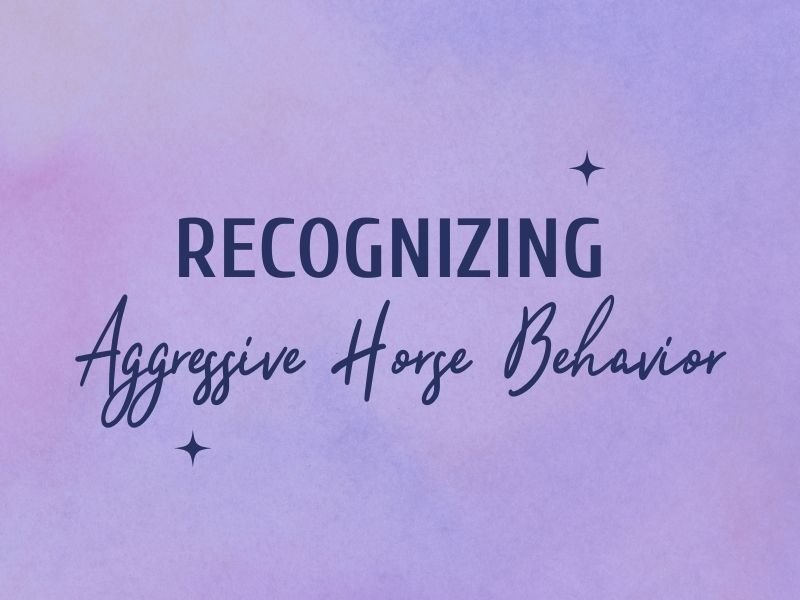
Recognizing Aggressive Horse Behavior
Before we dive into the nitty-gritty of handling aggressive horses, let’s take a moment to understand what exactly we’re dealing with. Knowing how to recognize aggressive behavior in horses is crucial to maintaining a safe and positive environment for you and the horse.
Body language and signals
Horses are masters of body language.
Their facial expressions, body posture, and even the flick of a tail can speak volumes about their mood.
In addition to the common signs of aggression we’ve already covered, horses can display more subtle cues, such as kick threats or retracted lips.
And let’s not forget the playful aggression often seen among young horses! It’s essential to pay attention to these cues, as a horse’s primary means of communication is through body language.
- Flattening ears
- Baring teeth
- Moving tail rapidly
- Cocking or stamping a hind leg
- Kicking or biting
- Snaking neck
- Bowing head
- Rearing or squealing
When faced with an aggressor, horses can also show submissive behavior, such as avoiding confrontation, lowering their neck and head, clamping their tail, or turning away.
Common causes of aggression
Aggression in horses can have various causes.
In addition to fear, pain, frustration, social groupings, early socialization, medical conditions, and resource competition, there are a few more factors to consider:
- Association with negative or painful experiences
- Sexual or hormonal reasons
- Learned behavior
- Dominance issues
Understanding the root cause of aggression can help inform your approach and ultimately lead to a more successful outcome.
So, as we navigate the complexities of aggressive horse behavior, always keep in mind that patience, empathy, and knowledge are the keys to building trust and turning that aggression into a thing of the past.
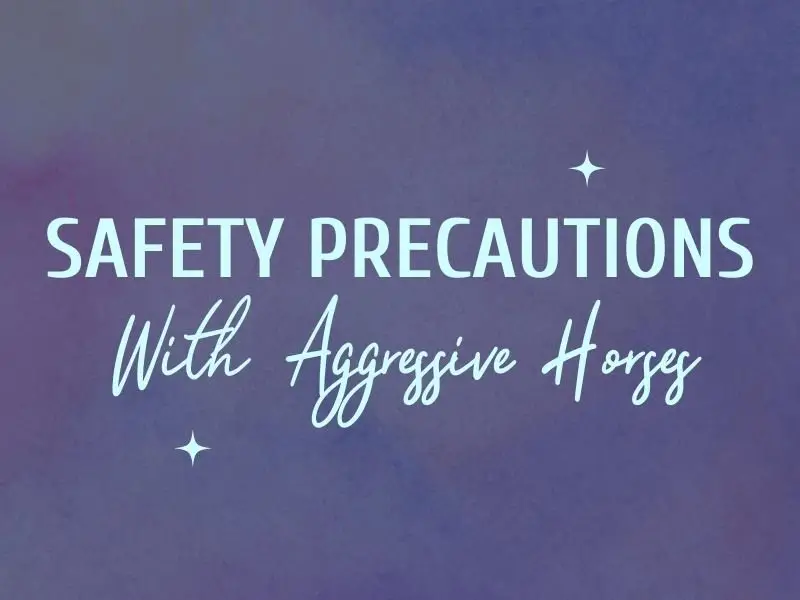
Safety Precautions with Aggressive Horses
Now that we’ve got a grasp on what we’re dealing with, let’s talk about safety. After all, your well-being is the top priority when handling an aggressive horse.
Importance of maintaining a safe distance
Maintaining a safe distance from aggressive horses is essential to avoid injuries from kicks, bites, strikes, or other threats.
A safe distance depends on the situation and the horse’s behavior, but generally, it’s advisable to stay out of their blind spots (directly in front or behind them) and stand close to their body when necessary.
Also, always have an escape plan or route in case the horse becomes unpredictable or dangerous.
Protective gear and clothing
When working with aggressive horses, it’s crucial to gear up.
Protective gear and clothing, such as gloves, boots, helmets, vests, and chaps, can help reduce the risk of injury.
Ensure your gear is comfortable, well-fitted, and appropriate for the task at hand. It should not restrict movement or vision or cause irritation or discomfort to the horse.
Regularly check your gear for wear and tear, and replace it if necessary.
Buddy system
There’s strength in numbers! Bringing along a knowledgeable and experienced friend or trainer can be a huge help when working with aggressive horses.
A buddy system involves having another person nearby who can help or intervene in case of an emergency or a problem with an aggressive horse.
This support system can provide guidance and feedback, especially for inexperienced or nervous handlers (who shouldn’t be working with aggressive horses to start with).
Clear communication, coordination, and cooperation between handlers are vital, along with respect for each other’s roles and responsibilities.
So, team up and tackle those challenging situations with confidence!
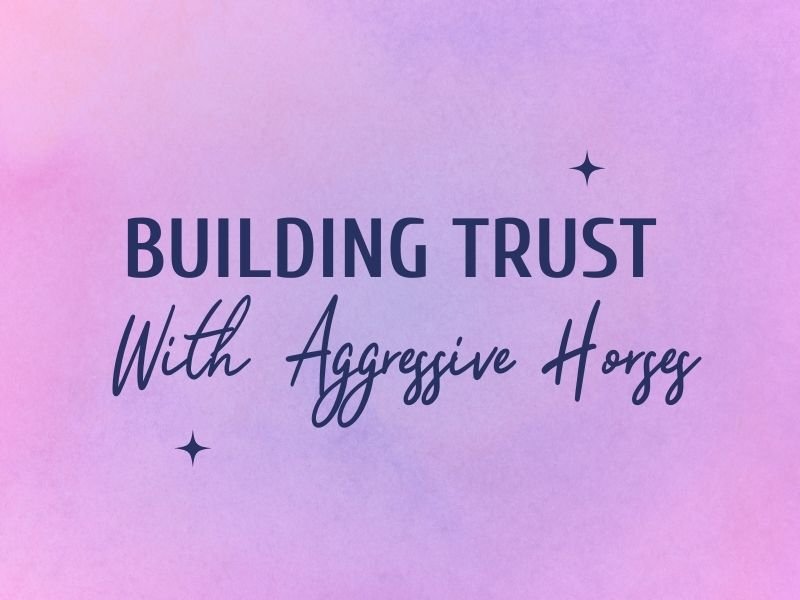
Building Trust with Aggressive Horses
Alright, we’ve covered the basics, and now it’s time to get to the heart of the matter: building trust with an aggressive horse. This is where the real magic happens.
Establishing a calm environment
Creating a serene and stress-free environment is key to building trust with an aggressive horse. Many horses act out due to fear or anxiety, so it’s important to minimize potential stressors.
Here are a few tips for creating a calm environment:
- Provide adequate space, shelter, food, and water for the horse
- Avoid loud noises or sudden movements
- Use soothing tones and gentle touches
- Consider calming supplements or aromatherapy to help reduce stress and anxiety
By setting the stage for a positive interaction, you’re already off to a great start.
Consistent and positive interactions
When working with an aggressive horse, consistency is crucial.
Establish a routine that includes regular interactions, grooming, and just spending time together.
This will help the horse become familiar with you and build a sense of trust.
During these interactions, stay positive and reward the horse for good behavior through verbal praise, gentle pats, or even the occasional treat (in moderation, of course).
However, avoid feeding treats by hand, as this may encourage biting or nipping, and if your horse is already like this then it will compound the issue. Try using a small rubber tub.
Patience and time investment
Building trust with an aggressive horse doesn’t happen overnight.It takes time, patience, and understanding.
Be prepared to invest a significant amount of time into this process, working with the horse at their own pace, and celebrating small victories along the way.
If needed, seek professional help from a veterinarian, a trainer, or an equine behaviorist.
Rome wasn’t built in a day, and neither is a strong bond with a previously aggressive horse.
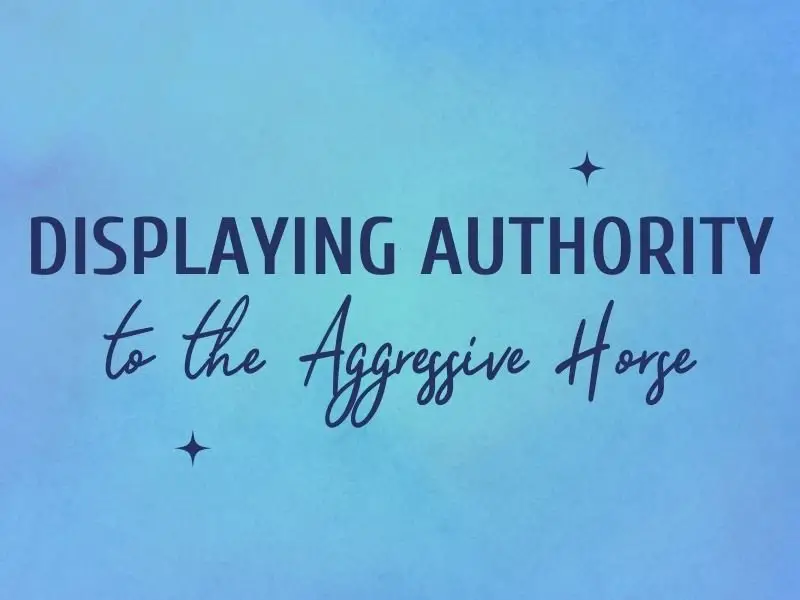
Displaying Authority to the Aggressive Horse
As important as it is to establish trust, it’s also essential to demonstrate that you’re the one in charge.
Horses are herd animals, and they naturally look to a leader for guidance. Here’s how to show your horse that you’re the leader.
Do You Have A Dominant Horse? – YouTube
Using body language effectively
Horses are sensitive to visual cues and signals, so using body language effectively can help communicate authority to an aggressive horse.
Here are some tips for conveying confidence:
- Stand tall and maintain eye contact
- Move with purpose and direction
- Use gestures or movements to direct the horse’s attention
- Avoid signs of fear, uncertainty, or submission, such as crouching, looking away, or hesitating
Voice commands and tone
Your voice is a powerful tool when working with horses.
To convey authority, use clear, consistent, and simple words or sounds to cue the horse for different behaviors or responses, such as “whoa,” “walk,” “trot,” or “back.”
Maintain a firm, calm, and assertive voice to correct or praise the horse, and avoid shouting, scolding, or whining.
Reinforcing desired behaviors
Reinforcing desired behaviors helps establish authority over an aggressive horse, as they learn to repeat or avoid behaviors based on their consequences.
Utilize positive reinforcement (adding something pleasant) or negative reinforcement (removing something unpleasant) to reward or encourage the horse for desired behaviors.
In some cases, you may also use positive punishment (adding something unpleasant) or negative punishment (removing something pleasant) to correct or discourage unwanted behaviors.
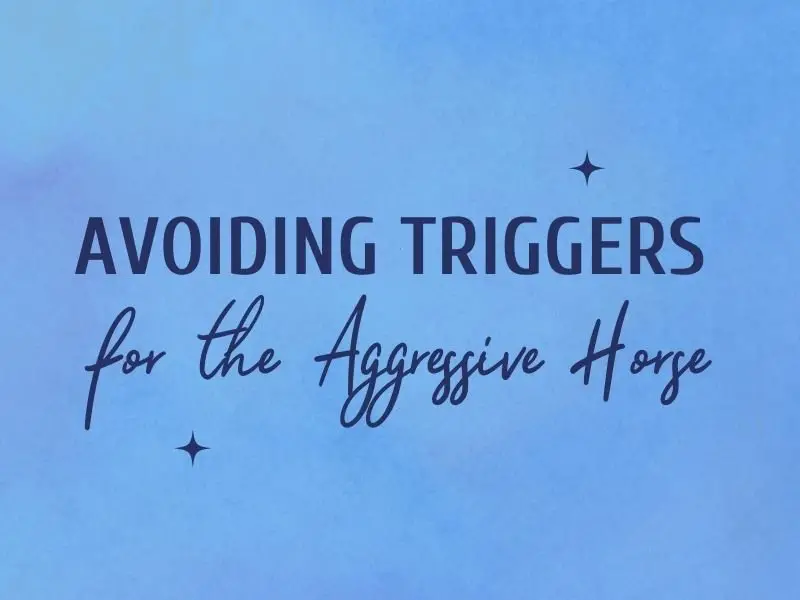
Avoiding Triggers for the Aggressive Horse
Now that we’ve established trust as well as authority, it’s important to recognize and avoid any triggers that may cause your horse to become aggressive.
Sudden movements and noises
Horses may perceive sudden movements and loud noises as threats or sources of fear or stress.
To avoid triggering aggression, consider these tips:
- Gradually and positively expose your horse to potential triggers using desensitization and counterconditioning techniques
- Be mindful of objects or situations that might startle your horse, such as loud vehicles, machinery, fireworks, or rustling plastic bags (because those bags are really scary!)
Understanding the horse’s personal space
Respecting a horse’s personal space can help avoid triggering aggression.
Keep these points in mind:
- Know how close to stand or approach the horse
- Be mindful of how you touch or handle the horse
- Teach the horse to respect your personal space, discouraging behaviors like pushing, shoving, crowding, or biting
Identifying and avoiding stressors
Preventing aggression in horses often involves identifying and avoiding stressors.
Here’s how:
- Recognize what causes stress for your horse, such as pain, illness, hunger, boredom, isolation, or changes in routine
- Provide adequate care and comfort, including regular veterinary check-ups, proper nutrition and hydration, suitable shelter and bedding, and social interaction and stimulation
Recognizing the horse’s body language
Understanding your horse’s body language can help you identify when they are feeling stressed or threatened, allowing you to take appropriate action and avoid potential triggers.
Pay attention to:
- Ears: If your horse’s ears are pinned back, they may be feeling threatened or uncomfortable
- Tail: A swishing tail can indicate agitation or annoyance but could also just be flies bugging your horse.
- Facial expressions: Tensed muscles, flared nostrils or bared teeth can be signs of stress or aggression
Providing proper training and exercise
Ensuring that your horse receives proper training and exercise can help prevent aggression, as it keeps them mentally and physically engaged:
- Implement a regular exercise routine, tailored to your horse’s needs and abilities
- Engage your horse in activities that challenge their mind and body, such as obstacle courses or trail rides
- Work with a professional trainer to address any behavioral issues and improve your horse’s overall demeanor
By being proactive and attentive to your horse’s needs, you can reduce the risk of aggressive behavior and create a more positive environment for both of you.
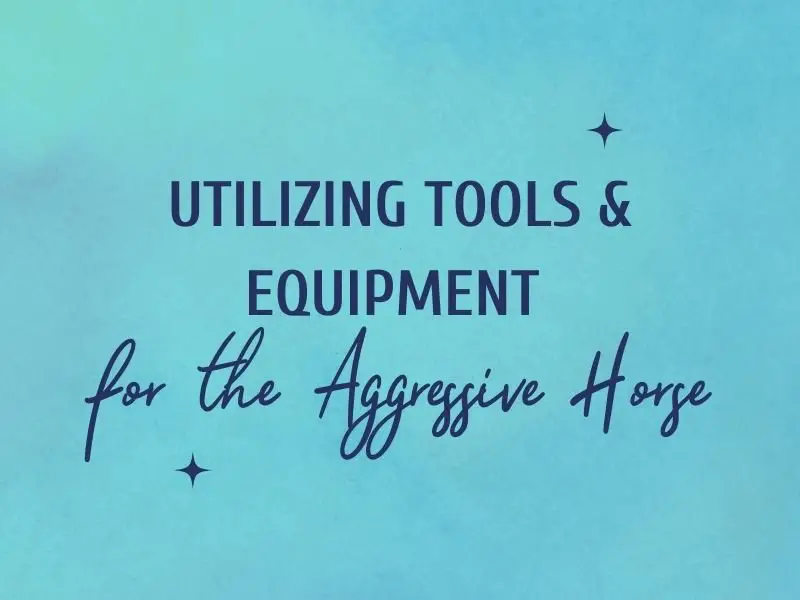
Utilizing Tools and Equipment for the Aggressive Horse
When working with an aggressive horse, having the right tools and equipment can make a significant difference. Here’s how to utilize these tools effectively.
The Lead Rope: Control and Communication
The lead rope is an essential tool for controlling and communicating with an aggressive horse, as it allows you to direct, guide, correct, or reward the horse’s movements and behaviors.
To use the lead rope effectively:
- Apply pressure or release to the horse’s halter, signaling them to stop, go, turn, back up, lower their head, or yield their body parts.
- Create a safe distance between yourself and the horse. Swing or snap the lead rope to deter or reprimand the horse if they become threatening or disrespectful.
Other Essential Equipment
Halter
- A well-fitted and comfortable halter allows you to control and communicate with your horse.
- It can be made of various materials, such as leather, nylon, or rope, and come in different designs, like a regular halter, a rope halter, or a training halter.
Whip
- A whip reinforces cues or commands, and is an extension of your arm.
- I do not condone using a whip to punish a horse. But there are certain circumstances using it more harshly for your protection.
- For example if a horse started to act dangerously aggressive and was actively trying to hurt you, a good hard smack for your safety is warranted to get the horse away from you.
- Use it sparingly and appropriately to avoid causing injury or fear.
- Select the type and length of the whip based on your needs, such as a crop, dressage whip, lunge whip, or driving whip.
Lunge Line
- A lunge line, when attached to the horse’s halter or bridle, allows you to work with the horse from a distance.
- Use it to exercise, train, or evaluate the horse’s movement, behavior, or soundness, and establish authority and respect by making the horse move in circles around you at varying speeds and directions.
Proper Handling and Usage
To work with an aggressive horse safely and effectively, it’s crucial to handle and use tools and equipment properly.
This includes:
- Inspecting the tools and equipment for wear and tear before use, and adjusting them to fit the horse correctly.
- Holding them securely and confidently, applying them gently and precisely, and removing them promptly after use.
- Using positive reinforcement (e.g., praise or treats) along with tools and equipment to reward the horse for good behavior, and avoiding overuse or misuse that could cause pain, fear, or resentment in the horse.
By following these guidelines, you’ll be able to effectively utilize tools and equipment when working with aggressive horses, ensuring a safer and more productive experience for both you and your horse.
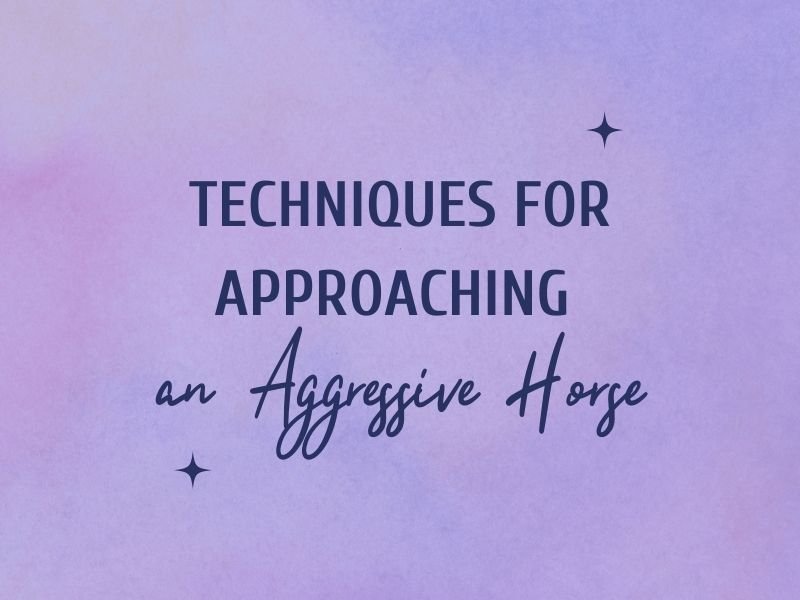
Techniques for Approaching an Aggressive Horse
Navigating the stormy waters of an aggressive horse can seem daunting, but with a step-by-step approach and a keen understanding of how to handle specific situations, you can safely and effectively approach these fiery equines.
Step-by-Step Approach
A structured, step-by-step approach is your key to success when dealing with an aggressive horse.
This allows you to assess the horse’s mood, behavior, and body language, and adjust your actions accordingly:
- Observe: Stand outside the horse’s reach and look for signs of aggression, such as pinned ears, bared teeth, swishing tail, or threatening posture.
- Connect: Speak to the horse calmly and confidently. Extend your hand with a treat or a glove, avoiding sudden movements or noises. Wait for the horse to show interest or curiosity.
- Approach: Slowly and steadily approach the horse from the front, toward his shoulder. Avoid his blind spots: behind and directly in front of him.
- Touch: Gently touch the horse’s neck or shoulder, praising him for accepting your touch. Avoid reaching for his head or rear, as these can trigger defensive reactions.
- Move: Carefully and calmly move around the horse, keeping your hand on him at all times. Stay close to his body and avoid his feet. Use a lead rope or a halter to guide him if needed.
Handling Specific Situations
Different situations call for different approaches. Here’s how to handle nervous or fearful horses and protective or territorial horses:
1. Nervous or Fearful Horses
Nervous or fearful horses may become aggressive when they feel trapped or threatened.
To handle these horses:
- Identify and avoid the source of fear or stress, or expose the horse to it gradually and positively using desensitization and counterconditioning techniques.
- Use a calm and soothing voice and touch to reassure the horse that he is safe and that you are not a threat. Avoid shouting, scolding, or hitting the horse.
- Provide companionship and confidence for the horse with a pony horse or a buddy system. Horses are herd animals and feel more secure in groups.
2. Protective or Territorial Horses
Protective or territorial horses can become aggressive when they feel their space, resources, or mates are being invaded or challenged.
To handle these horses:
- Respect the horse’s personal space and boundaries. Wait for him to invite you in by showing signs of relaxation or curiosity.
- Establish your role as a leader and teach the horse to respect you and your space. Use body language, voice commands, and tools such as a whip or a lunge line to direct, guide, correct, or reward the horse’s behaviors.
- Avoid feeding treats by hand, as this can encourage biting or nipping. Instead, use a bucket or a feeder to provide food for the horse.
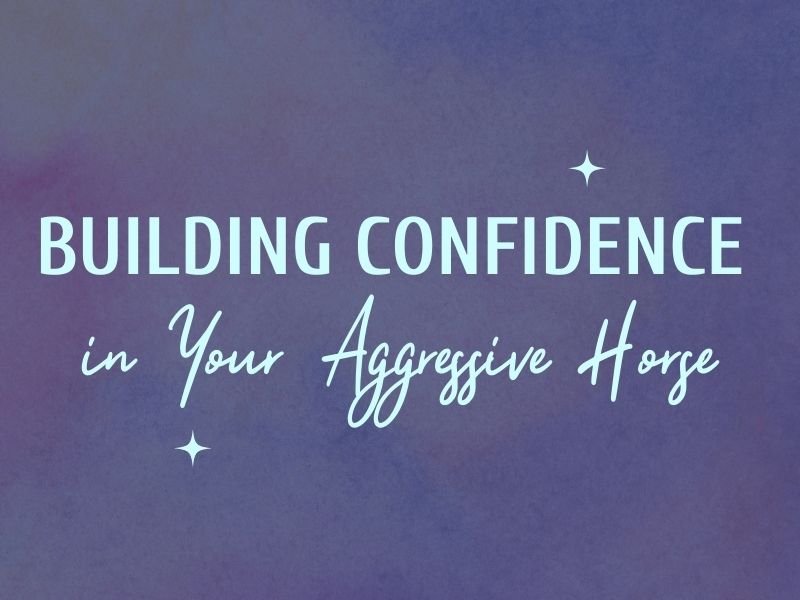
Building Confidence in Your Aggressive Horse
With a foundation of trust established, it’s time to focus on building confidence in your once-aggressive horse.
By fostering self-assurance, you’ll help your equine friend become more trusting and less prone to aggressive behaviors.
Desensitization and Counterconditioning
Desensitization and counterconditioning are powerful techniques for building confidence in your horse:
- Desensitization: Gradually expose your horse to triggers, starting at low intensity and increasing slowly, until the horse becomes accustomed and no longer reacts negatively.
- Counter-conditioning: Pair the stimulus with something positive, like a treat or praise, so the horse learns to associate it with something pleasant and changes their emotional response from negative to positive.
Socialization and Herd Dynamics
Social experiences and understanding herd dynamics also play a crucial role in building your horse’s confidence:
- Socialization: Expose your horse to different horses and humans in various settings and contexts, such as group rides, trailering with a buddy, or meeting new people at a show.
- Herd Dynamics: Understand how horses establish roles and relationships within a group (leader, follower, dominant, submissive, etc.) and how they express these through body language, vocalizations, and behaviors.
Ongoing Training and Reinforcement
Consistent training and reinforcement are essential for maintaining and improving your horse’s confidence:
- Ongoing Training: Teach your horse new exercises or tasks that challenge them mentally and physically. Break these down into small, manageable steps to set your horse up for success.
- Ongoing Reinforcement: Reward your horse for good behavior or performance, using positive reinforcement (treats, praise) or negative reinforcement (pressure release). Avoid punishment or coercion, which could cause fear or resentment.
By incorporating these strategies, you’ll help your once-aggressive horse become a more confident and trusting companion. Remember, this process requires patience, persistence, and understanding, but the rewards are well worth the effort!
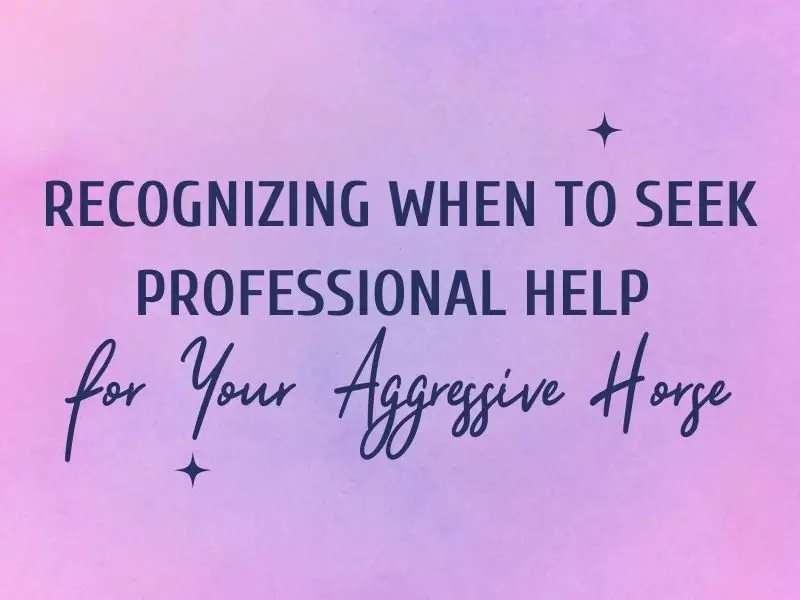
Recognizing When to Seek Professional Help for Your Aggressive Horse
Managing an aggressive horse can be a challenging and sometimes dangerous task.
Although patience, understanding, and the right approach can help improve the horse’s behavior, there are situations where seeking professional help is necessary to ensure the safety and well-being of both the horse and the handler.
Signs of Severe Aggression
It’s crucial to recognize the signs of severe aggression in your horse.
If you notice any of the following behaviors, consulting a professional may be the best course of action:
- Frequent or intense displays of aggressive behavior, such as biting, kicking, striking, charging, or rearing, particularly towards humans or other horses
- Unprovoked or unpredictable aggression that occurs without any apparent reason or warning
- Ignoring or resisting handler’s cues or corrections, indicating a lack of respect or trust
- A history of causing injury to humans or other horses, suggesting a pattern of dangerous behavior
Dangers of Handling Aggressive Horses Without Experience
Attempting to handle an aggressive horse without the necessary experience can be risky and may even exacerbate the horse’s behavior.
Some potential consequences include:
- Increased risk of serious injuries or death for the handler or the horse, as aggressive horses can cause significant harm if not managed correctly
- Reinforcement of the horse’s aggression, potentially making the behavior more difficult to address in the future
- Heightened fear, stress, or mistrust in the horse, which can lead to further behavioral problems and damage the relationship between the horse and the handler
Finding a Qualified Equine Behaviorist
A qualified equine behaviorist can help resolve your horse’s aggression problem safely and effectively by assessing the horse’s behavior, identifying the root cause of the aggression, and developing a customized treatment plan.
To find the right professional:
- Ask for referrals from your veterinarian, trainer, or other horse owners who have had success working with equine behaviorists.
- Research potential behaviorists by checking their credentials, experience, and looking for reviews or testimonials from previous clients. This can help ensure that you find a professional with a proven track record.
- Reach out to professional organizations, such as the International Association of Animal Behavior Consultants (IAABC), the American College of Veterinary Behaviorists (ACVB), or the International Society for Equitation Science (ISES), for recommendations and guidance in your search.
By recognizing the signs of severe aggression and knowing when to seek professional help, you can protect the safety and well-being of both you and your horse.
A qualified equine behaviorist can provide the expertise and guidance needed to address and overcome your horse’s aggressive behaviors, helping to create a more harmonious and trusting relationship.
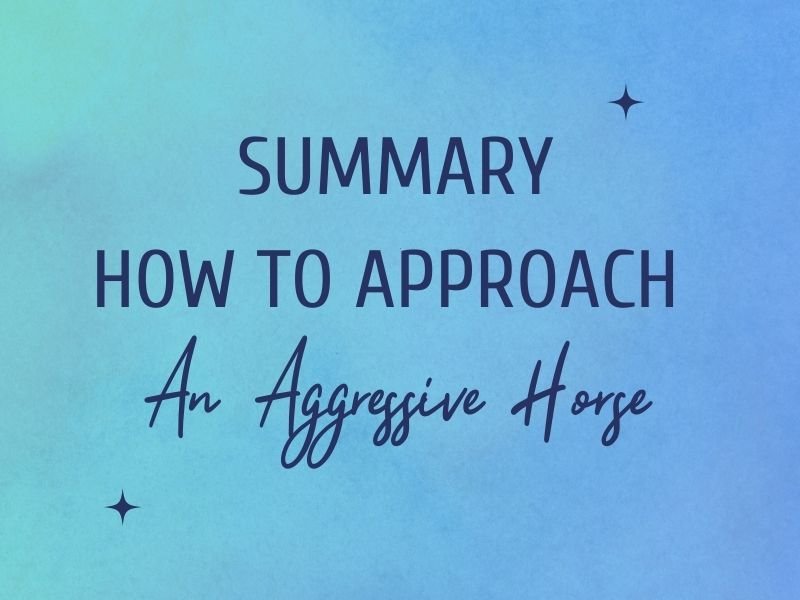
Summary How to Approach An Aggressive Horse
Managing aggressive horses can be challenging, but with the right knowledge and approach, you can build a strong, trusting relationship.
In this blog post, we’ve discussed the root causes of aggression, recognizing and responding to body language, and using appropriate tools and equipment. The key takeaways table provides a concise summary of these valuable insights.
I wrote this article to help horse owners and enthusiasts struggling with aggressive horses, equipping them with the necessary knowledge and techniques to understand and improve their horse’s behavior.
By applying the strategies discussed, you can foster a harmonious relationship with your horse.
Review the key takeaways table and reflect on how these insights can be applied to your situation. Remember, patience, understanding, and consistency are crucial.
If you’re overwhelmed or unsure, seek professional help.
With determination and the right approach, you can enjoy a rewarding partnership with your once-aggressive horse.
| Quick Look at the Key Takeaways |
|---|
| 1. Understand and address the root causes of aggression in horses |
| 2. Recognize and respond appropriately to aggressive body language cues |
| 3. Develop trust and mutual respect with consistent, positive interactions |
| 4. Utilize proper tools and equipment for safe and effective handling of aggressive horses |
| 5. Approach aggressive horses methodically using a step-by-step approach |
| 6. Adapt to specific situations and individual horse temperaments |
| 7. Foster confidence and trust in your horse through desensitization, counter-conditioning, and socialization |
| 8. Commit to ongoing training and reinforcement to maintain progress and strengthen the bond |
| 9. Seek professional help when faced with severe aggression or when inexperienced with aggressive horses |
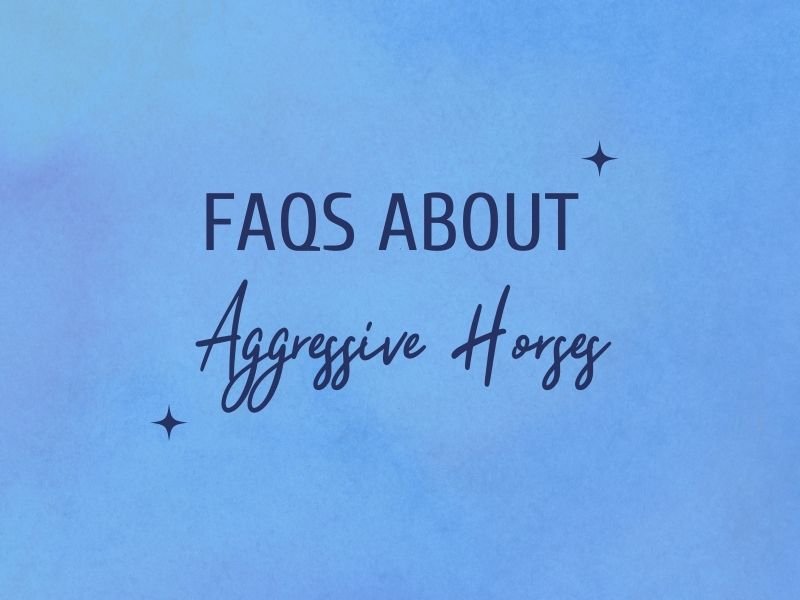
FAQs About Aggression In Horses
As we wrap up our exploration of handling aggressive horses, let’s address some frequently asked questions on this topic.
What Are The Common Signs Of Aggression In Horses?
Horses exhibit a range of behaviors when they’re feeling aggressive.
Common signs include:
-Ears flattened backward
-Retracted lips
-Rapid tail movements
-Snaking (head-swinging)
-Pawing
-Head bowing
-Fecal pile display
-Snorting
-Squealing
-Levade (rearing with deeply flexed hindquarters)
-Threats to kick
-Biting, kicking, striking, charging, or rearing at humans or other horses without provocation or warning
How Can I Prevent My Horse From Becoming Aggressive?
Preventing aggression in horses involves addressing the root causes and ensuring their overall well-being:
-Identify and remove the cause of aggression, such as fear, pain, frustration, stress, or hormonal imbalances.
-Provide adequate care and comfort for the horse through regular veterinary check-ups, proper nutrition and hydration, suitable shelter and bedding, and social interaction and stimulation.
-Establish yourself as a leader and teach the horse to respect and trust you, using body language, voice commands, and tools such as a whip or a lunge line to direct, guide, correct, or reward the horse’s behaviors.
When Should I Call A Professional For Help With An Aggressive Horse?
Knowing when to call a professional for help is essential for the safety of both you and your horse. Seek help:
-As soon as possible if the horse shows signs of severe aggression that pose a danger to himself or others.
-If the horse’s aggression doesn’t improve after ruling out physical or medical reasons and attempting to address behavioral issues.
-Find a qualified equine behaviorist or horse behavior consultant who can assess the horse’s behavior, identify the root cause of aggression, and provide a treatment plan that suits the horse’s needs and personality.
With these techniques for approaching aggressive horses, you’ll be able to work with them more safely and confidently, but don’t take on more than you can handle.
Cheers, Kacey
P.S. Did you like this article? Gallop over to:

